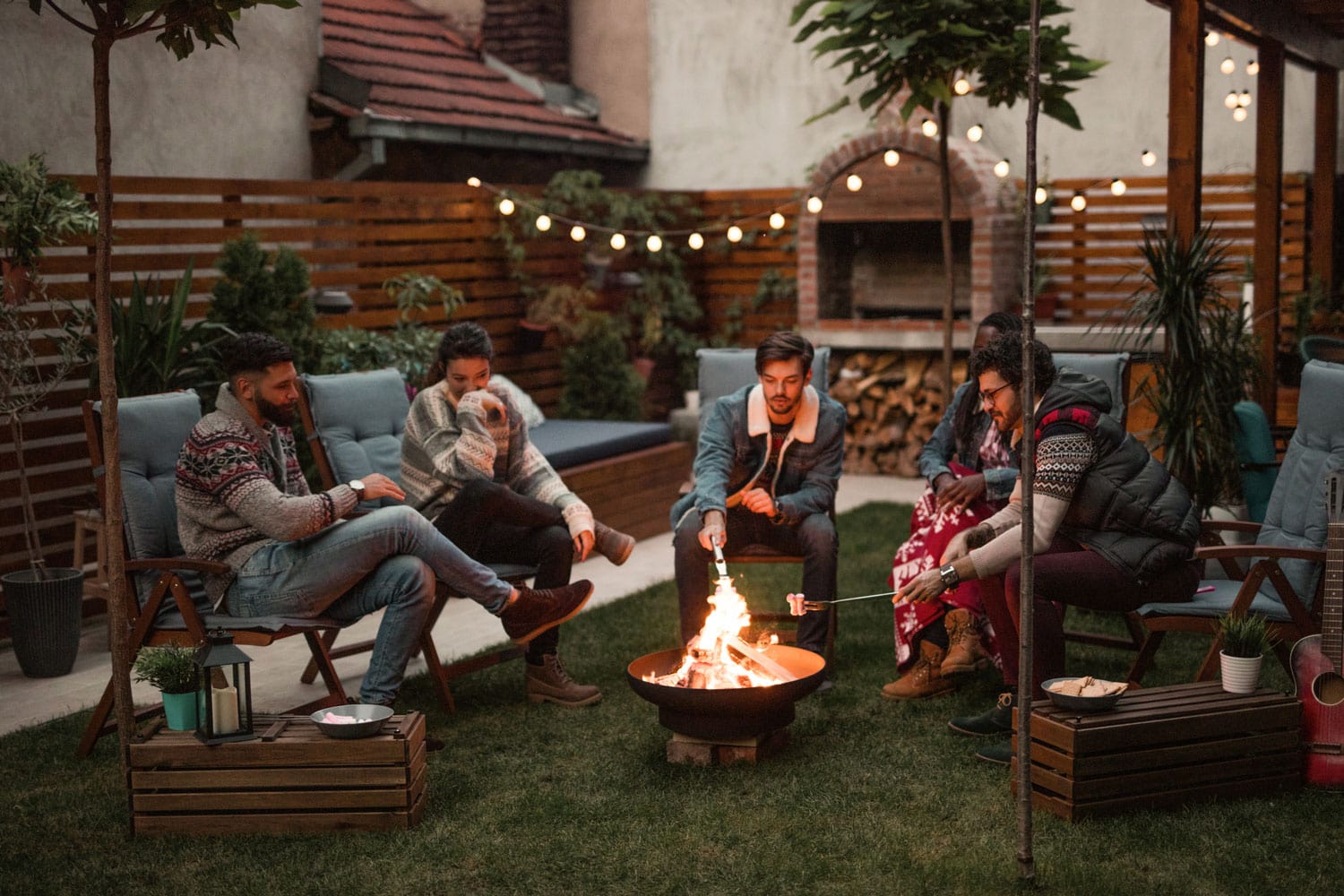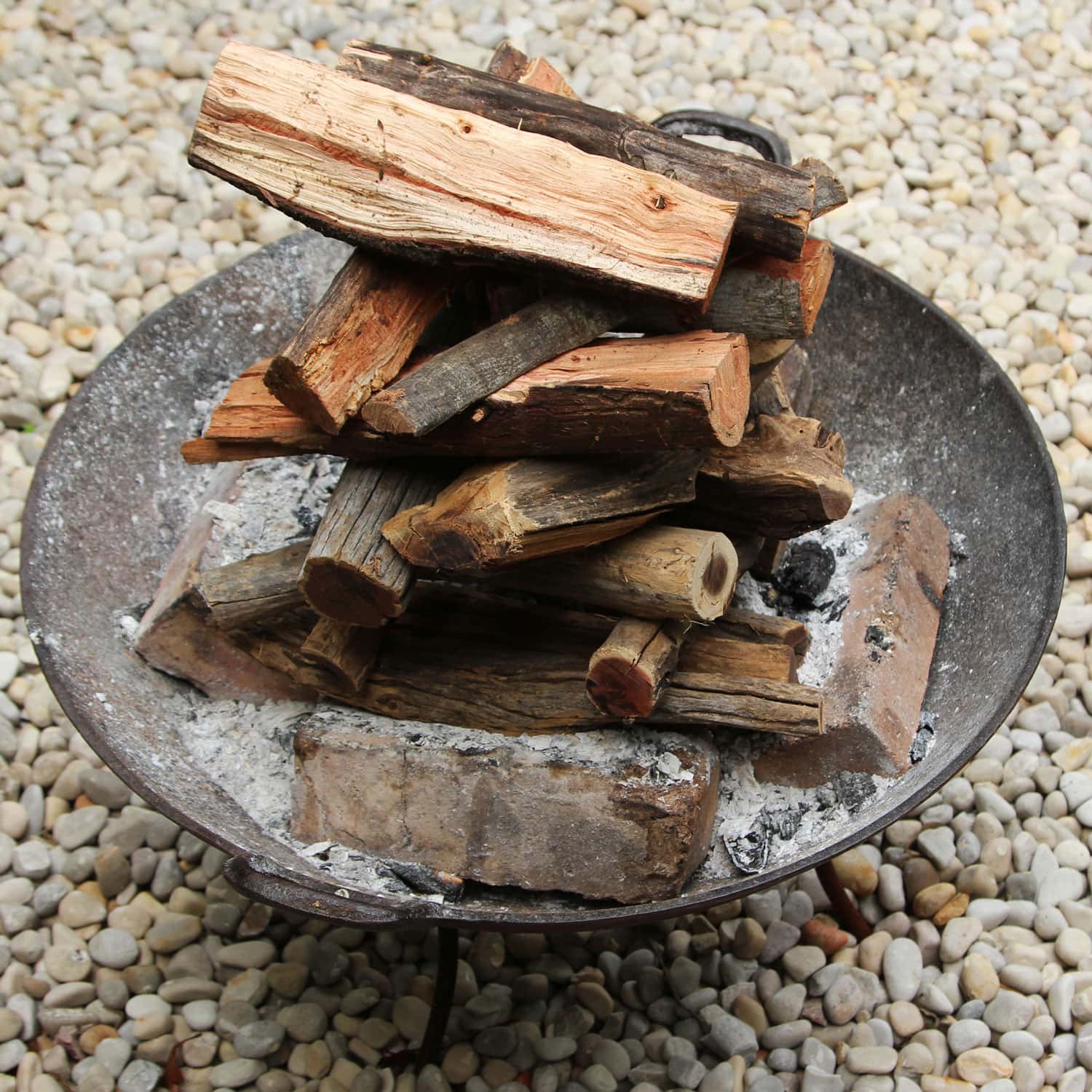- Arrange two pieces of wood, laid parallel, with space between them for airflow.
- Lay two pieces of wood on top of the first two, running in the other direction. The overall shape now should be a rectangle.
- Place kindling, special fire-starters, newspaper, or any other igniting materials in the space between the logs.
- Put another couple of logs on top, alternating the pattern. These ones will be parallel to the bottom logs.
- Light it up! Be sure to use a lighter long enough to reach between the logs, into the center kindling. Keep your hands back, outside the logs, and insert the lighter between a gap. Do not tip the lighter, as this increases the risk of burning yourself.
Note: Always use common sense and follow safety guidelines. You should never start a fire with flammable materials not intended for fire. Read all directions and only use items as indicated.
Read further for more fire-starting tips, including some great ideas for homemade fire starters. We'll teach you what you can burn and what will keep your fire going - safely! And if you have a hard time getting your fire lit, we'll troubleshoot some common causes.
![Large back yard with grass and covered patio with firepit, How To Start A Fire Pit [A Complete Guide]](https://hvacseer.com/wp-content/uploads/2021/05/How-To-Start-A-Fire-Pit-A-Complete-Guide.png)
The Right Way To Start A Fire
When you start a fire, it is important to build the wood up in a criss-cross, rectangular pattern. The bottom few pieces of wood make a parallel line. The next layer of wood goes in the opposite direction. This leaves natural gaps between the wood for airflow. Most people who can't keep a fire going can blame lack of airflow. Fire simply can't take off without oxygen, which can't reach wood all stacked in one big clump.
Lack of air and too-close wood also can cause excessive smoke. Other reasons for too much smoke or a poor fire can be that the wood isn't dry. A final reason can be trying to burn materials that really don't belong in a fire.
While, anecdotally, some people will swear that this-or-that is the best way to start a fire, it isn't always true or safe. If it isn't marketed for use in a fireplace, it might be best to skip it. Even if it burns, the air pollution may not be worth it. In particular, synthetic, manmade, or chemical-based products can create a toxic cloud that's hazardous to breathe in - even if it makes a great flame.
What Is The Best Thing To Burn In A Fire Pit?
It might sound obvious, but it's worth saying. The best thing to burn in a fire pit is wood. While some people may recommend less traditional materials, it's rarely a good idea. Many items can release toxins when exposed to high heat, which is a health risk you may not even realize you're facing.
Even wood has its own risks. Pressure-treated woods should never be burned for the same reason; they've potentially been exposed to chemicals that you don't want to inhale from a fire. Instead, try:
- Oak, a hardwood that will burn for a long time.
- Hickory, which burns very hot and produces a lot of heat.
- Pinion wood, also a hardwood, plus the pine fragrance repels mosquitos.
Wood should be dry and seasoned. But not necessarily too old. Make sure your wood is ready to burn by checking out "Can Firewood Be Too Old To Burn?"
Another option is compressed wood. It can be found in a number of forms, such as pellets, logs, or blocks. If you don't have access to typical cut hardwoods, these can be a great alternative. They tend to be more eco-friendly, made from recycled woods, and give off less carbon monoxide.
Click here to see this firelog on Amazon.
What Household Items Can You Use To Start A Fire?
You can use several useful household items in a pinch to start a fire. One of the best is dryer lint. It's free, generally useless for anything else, and easily accessible. Just set it aside and collect until you're ready to use it.
For a more crafty way to use dryer lint as a firestarter, put it into a cardboard egg carton. Fill each space with dryer lint and pour melted wax over the top. Be warned, the wax can and probably will leak and spill. Do this over a cookie sheet or other protective surface to minimize the mess. Let it harden, then cut apart the egg carton. You've crafted 12 firestarters, ready to go!
Cardboard is an obvious choice, but that can also be dipped in melted wax to improve burning. Wood shavings, such as from a pencil sharpener or woodworking, are another resource.
One less obvious selection is tampons. You can pull them apart and use the fluff. However, this may really only be useful in an emergency. Tampons aren't really any cheaper to burn than an actual firestarter purchased from a store, after all. A cheaper item might be cotton balls. If you soak them in a bit of petroleum jelly first, they can burn for up to five minutes.
How Do You Make A Fire Last Longer?

For a longer-lasting fire, follow the original directions of stacking wood for a fire. However, instead of leaving a gap for kindling in the bottom layers, use extra logs. Put three or four logs in the bottom row, but still leave a gap between logs for air. In the next layer, you'll use extra logs and place them in the opposite direction. Stack a few layers this way, and put the kindling/paper/fire-starting material at the TOP instead.
This will create a fire that's a bit slow to take off. But, as the embers slowly burn and drop down, they'll ignite the next layer. Each layer will spread to the one below in a slow, methodical fashion that makes the fire burn significantly slower.

Another tip is to use lots of hardwood, though softwood is great for kindling. And make sure to use well-dried wood. Old, dry woods will burn better and slower. Read more about picking wood here: "3 Slowest Burning Types of Wood for your Fireplace."
What Do You Put In The Bottom Of A Fire Pit?
Before you decide what to use for the bottom of your firepit, you'll want to check local codes. Some cities have specific instructions as to what materials can be used.
If you do get to choose, you might wonder if you can't just put the fire pit right on the grass. There are two significant downfalls to this:
- Grass can be flammable, especially when dry. Although, you should avoid starting any unnecessary fires when the grass is dry.
- Putting the firepit directly in the lawn will lead to scorched, damaged grass. This will prevent you from being able to remove or relocate the firepit in the future. Or at least, it will leave you behind with a major eyesore.
Materials that you can use to line the bottom of a firepit include silica sand, dirt, stones, or gravel. Note that rocks, potentially, can absorb water and then explode when heated in a fire. For this reason, be careful what rocks you use. Small stones like gravel are ideal, as are fire-rated bricks. Avoid river rocks. You can also consider lava rocks a very safe choice for heat. Find these at a home improvement store near you or on Amazon.
Click here to see these lava rocks on Amazon.
As one final option, consider installing a concrete slab to place the firepit on. While a bit more expensive than other options, the heat from the concrete will help to keep a fire going for a long time.
In Conclusion
![Large back yard with grass and covered patio with firepit, How To Start A Fire Pit [A Complete Guide]](https://hvacseer.com/wp-content/uploads/2021/05/Large-back-yard-with-grass-and-covered-patio-with-firepit.jpg)
To start a fire pit, it is critical to stack the wood in layers, leaving room for airflow. Stack the first layer with parallel logs. Then, place logs on top oriented in the other direction. Add kindling to the center, and enjoy! For a longer-lasting fire, use more logs in the bottom layers, keeping kindling on top. Always be sure to use proper safety protocols, and never light anything that doesn't belong in a fire. Have fun making summer memories beside your amazing campfire!


